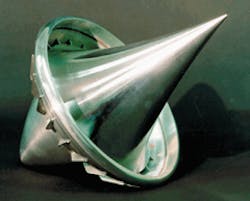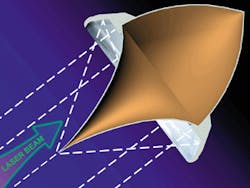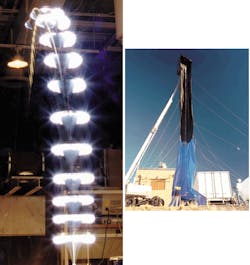On March 16, 1926, Robert H. Goddard stood in a snow-covered field on his Aunt Effie`s farm in Massachusetts and watched the first launch of his 17-year dream, the liquid-propelled rocket. It stood 4 ft high, was 6 in. in diameter, and exhausted its fuel in 2.5 s, but the rocket reached a height of 41 ft and gave birth to a new era of human exploration.
Goddard`s early work serves as inspiration for scientists at Edwards Air Force Base, CA, as they attempt to open a new path into space with the use of laser light. The Lightcraft vehicle under development carries no on-board fuel; instead, it is propelled upward by 450-J pulses from a 20-Hz, 9-kW carbon dioxide (CO2) laser that fires the vehicle`s air-breathing engine.
First proposed and developed by Leik Myrabo of Rensselaer Polytechnic Institute (RPI; Troy, NY), the work is now a collaboration with senior scientist Franklin Mead of the Air Force Research Laboratory`s Propulsion Directorate at Edwards. Recent flights at the High Energy Laser Systems Test Facility (HELSTF) at White Sands Missile Range in New Mexico have reached a height of 75 ft in 3 s.
The Lightcraft vehicle, machined from a solid block of 6061-T6 aluminum by RPI machinist Mark Mickiewicz, is 13.5 cm in diameter and weighs 42.5 g (see Fig. 1). Its propulsion system is based on a laser directed onto a parabolic reflector located at the rear of the vehicle (see Fig. 2). The reflector acts as a concentrator for the beam. Air is rapidly heated and forced out the back of the nozzle to propel the vehicle. The Pulsed Laser Vulnerability Test System produces 10.6-µm light in pulses of 18 µs and was specially built for the Army by Avco-Textron (Providence, RI). At 9 kW, it is the highest-average-power, pulsed CO2 laser currently operating in the USA.After beam-shaping optics—which also redirect the beam to be vertical—the beam is 6.67 cm square, with a 3.3-cm square hole in its middle. Because it carries no onboard propellant, Lightcraft is not a "rocket." Its specific impulse, the ratio of thrust to propellant mass flow rate, is infinite. About 100 to 200 newtons of thrust is produced per megawatt of laser power, Myrabo said.
Based on SDI technology
In earlier tests, various Lightcraft were laboratory tested and then propelled 400 ft down a horizontal wire-guide. In vertical free flights, an air jet is applied before liftoff to spin the craft up to 3000 to 6000 rpm to provide gyroscopic stability. The laser beam actively locks onto the target via a pointing and tracking guidance system borrowed from mature Strategic Defense Initiative (SDI) technology. The backside of the vehicle is illuminated, down the optical train, by a powerful spot lamp. Input from a television camera is linked via software to the steering mechanism of the beam, which is a molybdenum mirror with servo motors on its backside that drives the beam through a 5-mrad angle.
A more sophisticated guidance system that includes steering capabilities is scheduled for sometime in the near future. On its most recent 75-ft launch, the CO2 laser propelled the Lightcraft vehicle to an initial acceleration of about 2 g. Within 20-50 ft from the ground the vehicle reached a terminal velocity of about 1 ft/pulse, at 20 Hz (see Fig. 3)."The goal for the next year and a half is to propel it to at least a kilometer, vertically, in free flight," said Myrabo. Current limits on height are mainly beam diffraction and beam distortion that, combined, spread the beam`s energy over too large a spot on the target. "We`re going to have to use a Cassegrain telescope that`s kept focused on the vehicle and fly in the far field," Myrabo said, "and work on bigger optics for the future."
The long-term goal of the program is to propel small "picosatellites" into orbit. Such satellites would be about 0.5 to 1 m in diameter, with a mass on the order of a kilogram. After being laser-powered to a speed of Mach 5 and 30 km altitude in the air-breathing propulsion mode, the vehicle would escape the remaining atmosphere by converting to laser-heated rocket propellant. While the technology cannot replace chemical rockets for heavy lifting, Myrabo speculated on its possibility for sending manned crafts into space on satellite beams powered by solar energy. Such designs might only require 10% to 20% of the initial mass to be propellant. That`s a far cry from missions such as the recently launched Cassini orbiter, which required about 940,000 kg of launch vehicle and propellant to put the 5600-kg craft on its way.
Long ago Goddard captured the possibilities: "It is difficult to say what is impossible, for the dream of yesterday is the hope of today and the reality of tomorrow."
About the Author
David Appell
Assistant Editor, Technology
David Appell was Assistant Editor, Technology for Laser Focus World.


